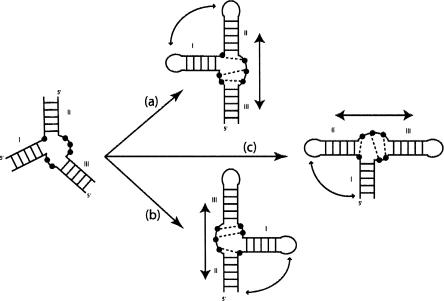FIGURE 1.
Example of a hypothetical three-way junction. The Watson-Crick paired helices are indicated by the ladders. Depending on the structure of the internal junctions, two of the three helices may stack coaxially. In the example shown, helices II and III stack coaxially. Arbitrary non-Watson-Crick contacts are shown as dotted lines. This coaxial stack is maintained whatever the precise secondary structure (whether two loops or only one or none are capped, or whether the closing loops are internal loops in longer helices). In case (a), potential tertiary contacts would occur between loops I and II; in case (b), the contacts would occur potentially between loop I and helix II (or an internal loop within helix II); and in case (c) the contacts would occur potentially between loop II and helix I (or an internal loop within helix I).

